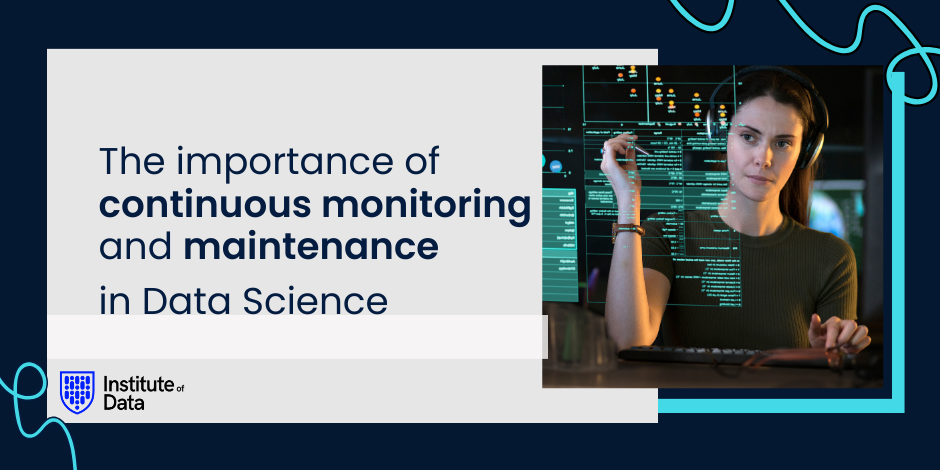The Importance of Continuous Monitoring and Maintenance in Data Science

Stay Informed With Our Weekly Newsletter
Receive crucial updates on the ever-evolving landscape of technology and innovation.
The world of data science is a complex and rapidly growing industry.
Global data creation is projected to surpass 180 zettabytes by 2025, and the installed base of storage capacity is expected to grow at a compound annual growth rate of 19.2% between 2020 and 2025.
With the constant influx of new data, ensuring that the systems and processes in place are functioning optimally is imperative.
This is where the importance of continuous monitoring and maintenance in data science comes into play.
Continuous monitoring and maintenance are not just about keeping systems running smoothly.
They ensure the data being processed is accurate, reliable, and relevant.
Essentially, they are about maintaining the integrity and value of the data science endeavor.
Understanding continuous monitoring and maintenance in data science

Before jumping into the importance of continuous monitoring and maintenance in data science, it is crucial to understand what these terms entail.
Continuous monitoring is regularly checking and analyzing the performance and functionality of data systems and processes.
It involves identifying and addressing any issues or anomalies, ensuring the systems and processes remain efficient and effective.
On the other hand, maintenance involves regular upkeep and improvement of data systems and processes.
It includes updating software, fixing bugs, improving functionality, and enhancing security.
Maintenance ensures that the systems and processes remain up-to-date, secure, and capable of handling the ever-increasing volume and complexity of data.
The role of continuous monitoring in data science
Continuous monitoring plays a vital role in data science.
It helps promptly identify and rectify any issues or anomalies in data systems and processes.
This ensures the smooth functioning of the systems and processes and maintains the data’s accuracy and reliability.
Continuous monitoring also aids in maintaining the relevance of the data. With the rapid pace of change in today’s world, data can quickly become outdated or irrelevant.
Continuous monitoring helps identify and update or replace such data with more current and relevant data.
This ensures that the insights derived from the data are valid and actionable.
The role of maintenance in data science
Maintenance, too, plays a crucial role in data science. Regular upkeep and improvement of data systems and processes ensure that they remain efficient and effective.
Maintenance activities such as updating software, fixing bugs, and enhancing security help keep systems and processes up-to-date and secure.
The importance of continuous monitoring and maintenance in data science

Continuous monitoring and maintenance in data science cannot be overstated.
They are the backbone of any successful data science endeavor.
They ensure that the systems and processes are functioning optimally, that the data being processed is accurate, reliable, and relevant, and that the insights derived from the data are valid and actionable.
Continuous monitoring and maintenance also help maintain the integrity and value of the data science endeavor.
They ensure that the systems and processes remain up-to-date, secure, and capable of handling data’s ever-increasing volume and complexity.
They also help promptly identify and address any issues or anomalies, thereby preventing potential damage or loss.
Ensuring accuracy and reliability
One of the key benefits of continuous monitoring and maintenance in data science is that they ensure the accuracy and reliability of the data being processed.
Regularly checking and analyzing the performance and functionality of the data systems and processes can identify and rectify any issues or anomalies promptly.
This ensures that the data being processed is accurate and reliable, thereby enhancing the validity and reliability of the insights derived from the data.
Continuous monitoring and maintenance also help in maintaining the relevance of the data.
This is particularly important in today’s rapidly changing world, where data can quickly become outdated or irrelevant.
Maintaining efficiency and effectiveness

Another key benefit of continuous monitoring and maintenance in data science is that they help maintain the efficiency and effectiveness of the data systems and processes.
Regular upkeep and improvement of the systems and processes ensure that they remain efficient and effective.
This enhances the performance of the systems and processes and improves the quality of the data being processed and the insights derived from it.
Continuous monitoring and maintenance in data science also ensure that the systems and processes can handle the ever-increasing volume and complexity of data.
This is particularly important in today’s data-driven world, where the volume and complexity of data are growing exponentially.
Without continuous monitoring and maintenance, the systems and processes may become overwhelmed and ineffective, compromising the integrity and value of the data science endeavor.
Conclusion
The importance of continuous monitoring and maintenance in data science is immense.
It is the backbone of any successful data science endeavor.
Explore the Institute of Data’s comprehensive Data Science & AI program to learn more about the importance of continuous monitoring and maintenance in data science.
Alternatively, we invite you to schedule a complimentary career consultation with a member of our team to discuss the program in more detail.




